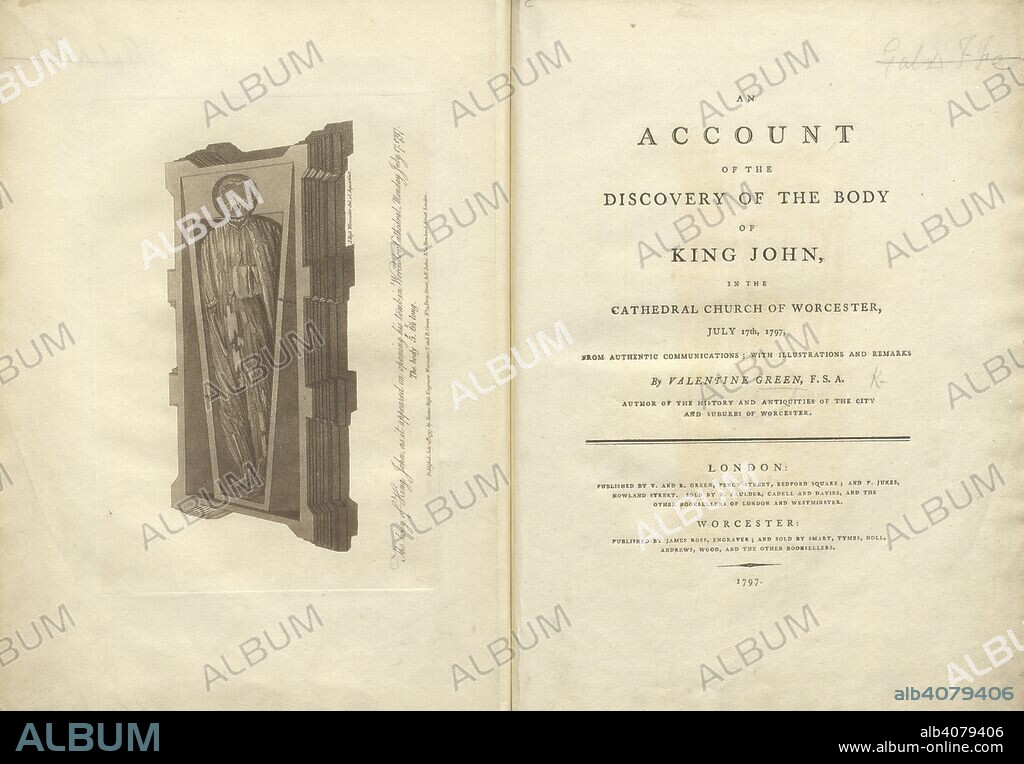alb4079406
In 1797 the tomb of King John at Worcester Cathedral was opened at the prompting of the engraver Valentine Green (d. 1813). Green had written a history of the city of Worcester, and had come to doubt previous descriptions of the tomb and its contents, among which was a longstanding contention that John had been buried elsewhere within the church. The effigy was removed first, followed by the slab on which it rested; inside the tomb chest, a stone coffin was discovered, containing the royal remains. The Dean and Chapter of Worcester Cathedral were immediately summoned, and inspection made of the King’s body. Green describes how thousands thronged to see King John before the tomb was restored the next day and the coffin closed to sight. Opposite the title page of Green’s account is this engraving, inscribed, ‘The body of King John, as it appeared on opening his tomb in Worcester Cathedral, Monday July 17 1797’. An account of the discovery of the body of King John in the Cathedral Church of Worcester, July 17, 1797, etc. London ; Worcester, 1797. Source: 814.l.23, frontispiece and title page. Language: English.

|
Ajouter à une autre Lightbox |
|
Ajouter à une autre Lightbox |



Avez-vous déjà un compte? S'identifier
Vous n'avez pas de compte ? S'inscrire
Acheter cette image

Légende:
Voir la traduction automatique
In 1797 the tomb of King John at Worcester Cathedral was opened at the prompting of the engraver Valentine Green (d. 1813). Green had written a history of the city of Worcester, and had come to doubt previous descriptions of the tomb and its contents, among which was a longstanding contention that John had been buried elsewhere within the church. The effigy was removed first, followed by the slab on which it rested; inside the tomb chest, a stone coffin was discovered, containing the royal remains. The Dean and Chapter of Worcester Cathedral were immediately summoned, and inspection made of the King’s body. Green describes how thousands thronged to see King John before the tomb was restored the next day and the coffin closed to sight. Opposite the title page of Green’s account is this engraving, inscribed, ‘The body of King John, as it appeared on opening his tomb in Worcester Cathedral, Monday July 17 1797’. An account of the discovery of the body of King John in the Cathedral Church of Worcester, July 17, 1797, etc. London ; Worcester, 1797. Source: 814.l.23, frontispiece and title page. Language: English.
Crédit:
Album / British Library
Autorisations:
Modèle: Non - Propriété: Non
Questions sur les droits?
Questions sur les droits?
Taille de l'image:
5004 x 3476 px | 49.8 MB
Taille d'impression:
42.4 x 29.4 cm | 16.7 x 11.6 in (300 dpi)
Mots clés:
18 18E 18EME XVIII XVIIIE XVIIIEME SIECLE • 18E SIECLE • 18EME S • CAVEAU • DÉCÈS • DÉFUNT • DIX-HUITIÈME SIÈCLE • DOCUMENT • ECRITURE LIVRES • ÉVÉNEMENT • FRONTISPICE • FUNÉRAIRE • GISANT • LIBERTE • LIVRE (OUVRAGE) • LIVRE • LIVRES • MAUSOLEE • MORT TOMBEAU • MORT • RELIQUAIRE • SÉPULCRE • SÉPULTURE • TEXTE • TOMBE • TOMBEAU • TOMBEAUX • TOMBÉS • XVIIIE SIECLE
 Pinterest
Pinterest Twitter
Twitter Facebook
Facebook Copier le lien
Copier le lien Email
Email
